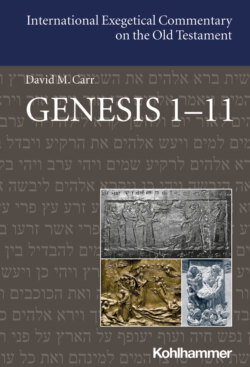Читать книгу Genesis 1-11 - David M. Carr - Страница 21
На сайте Литреса книга снята с продажи.
Diachronic Prologue Genesis 1:1–2:3 as Priestly and Its Relations to Gen 2:4b–3:24
ОглавлениеGenesis 1:1–2:3 has long been recognized as a key part of a broader Priestly Source extending at least into the Tabernacle Narrative at the conclusion of Exodus. The chapter as a whole is saturated by vocabulary and phrases that are otherwise mostly attested in Priestly contexts, e.g., ברא (“create”; Gen 1:1, 21, 27; 2:3); בדל (hiphil, “separate, divide”; Gen 1:4, 6, 14, 18), חית הארץ (“[wild] animals of the earth”; 1:24, 25, 30), מין (“kind”; Gen 1:11, 12, 21, 24, 25), רמש/רֶמֶשׁ (“crawl/creeping thing” Gen 1:21, 24–26, 28, 30), שרץ (“swarm”; Gen 1:20, 21) and לאכלה (“for food”; Gen 1:29, 30).21 More importantly, as we will see in the following commentary, the chapter introduces key themes that are unfolded in subsequent Priestly texts about the flood, Israel’s ancestors, and the story of Moses.
This Priestly creation account in Gen 1:1–2:3 (Gen 1) in turn is literarily distinct from the following non-Priestly Eden story in Gen 2:4b–3:24 (Gen 2–3) along with the P-like superscription in Gen 2:4a that bridges the two texts. These latter texts will be discussed in the commentary on Gen 2:4–3:24. For now it is just important to consider the potential relationship between Gen 1 and Gen 2–3. Whereas older scholarship tended to see these two creation narratives as either originally parallel or Gen 1 as dependent in some way on Gen 2–3, a number of recent studies have suggested instead that Gen 2–3 was composed from the outset as a post-Priestly expansion of the Gen 1 creation account.
This commentary likewise sees these two texts as related, but with Gen 1 later than and dependent on Gen 2–3, particularly at its beginning (Gen 1:1–3; cf. 2:4b–7) and end (Gen 1:26–30; cf. Gen 3:22, also 2:16–17). Though neither text cites the other, the beginning of Gen 1:1–2 structurally parallels that in Gen 2:4b–5 (see the Excursus on Translation below). More importantly, God’s speech to the divine council in Gen 1 about the making of humanity “as our image, similar to our likeness” (Gen 1:26) specifically contrasts with the non-P report of Yhwh’s speech to the divine council expressing concern about an emergent human similarity to God caused by the human attainment of godlike wisdom (Gen 3:22).22 These elements, along with some apparent blind motifs from Gen 2–3 in Gen 1, suggest that Gen 2–3 is one of the precursors to Gen 1.23
